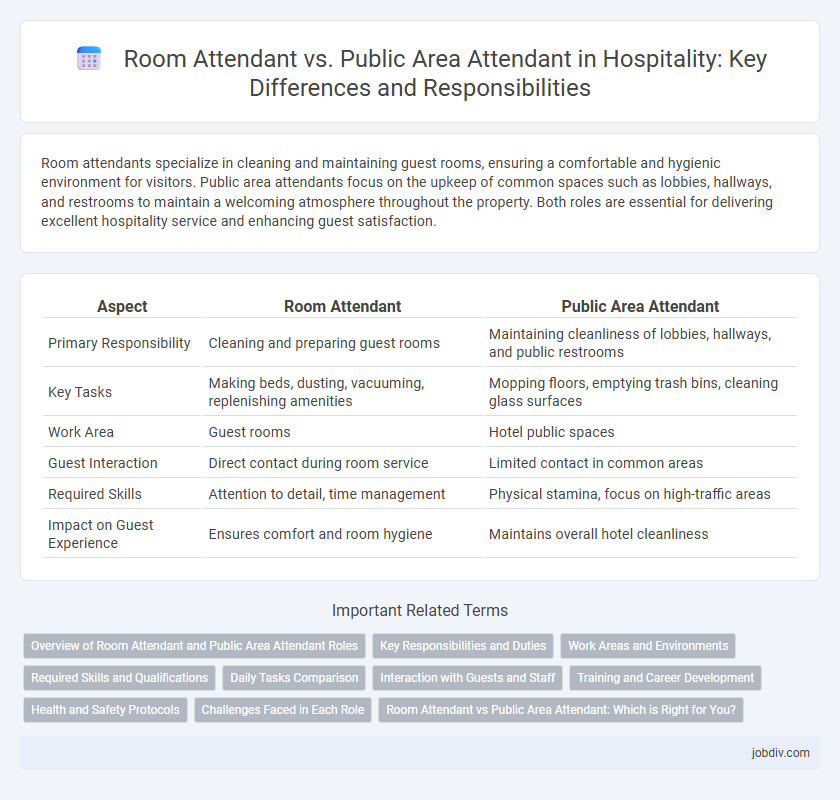Room attendants specialize in cleaning and maintaining guest rooms, ensuring a comfortable and hygienic environment for visitors. Public area attendants focus on the upkeep of common spaces such as lobbies, hallways, and restrooms to maintain a welcoming atmosphere throughout the property. Both roles are essential for delivering excellent hospitality service and enhancing guest satisfaction.
Table of Comparison
| Aspect | Room Attendant | Public Area Attendant |
|---|---|---|
| Primary Responsibility | Cleaning and preparing guest rooms | Maintaining cleanliness of lobbies, hallways, and public restrooms |
| Key Tasks | Making beds, dusting, vacuuming, replenishing amenities | Mopping floors, emptying trash bins, cleaning glass surfaces |
| Work Area | Guest rooms | Hotel public spaces |
| Guest Interaction | Direct contact during room service | Limited contact in common areas |
| Required Skills | Attention to detail, time management | Physical stamina, focus on high-traffic areas |
| Impact on Guest Experience | Ensures comfort and room hygiene | Maintains overall hotel cleanliness |
Overview of Room Attendant and Public Area Attendant Roles
Room attendants are responsible for cleaning, maintaining, and organizing guest rooms to ensure a comfortable and hygienic environment. Public area attendants focus on sanitizing lobbies, hallways, restrooms, and other common spaces to uphold safety and aesthetic standards throughout the property. Both roles are essential in delivering exceptional guest experiences and maintaining overall hotel cleanliness.
Key Responsibilities and Duties
Room Attendants are responsible for cleaning guest rooms, including making beds, replenishing toiletries, vacuuming, dusting, and ensuring overall guest comfort and hygiene. Public Area Attendants focus on maintaining cleanliness and order in communal spaces such as lobbies, hallways, restrooms, and conference rooms by sweeping, mopping, disinfecting surfaces, and managing waste disposal. Both roles require attention to detail, adherence to health and safety standards, and timely reporting of maintenance issues to ensure a pleasant environment for guests.
Work Areas and Environments
Room Attendants primarily work within guest rooms, focusing on cleaning, restocking, and maintaining a comfortable, sanitary environment tailored to individual guests. Public Area Attendants operate in communal spaces such as lobbies, hallways, and restrooms, ensuring these high-traffic zones remain clean, safe, and visually appealing. Both roles require attention to detail but differ significantly in their spatial focus and interaction with guests.
Required Skills and Qualifications
Room Attendants require strong attention to detail, proficiency in cleaning techniques, and the ability to manage time efficiently to maintain guest rooms at high standards. Public Area Attendants must possess excellent physical stamina, knowledge of public hygiene protocols, and skills in handling cleaning equipment for large spaces such as lobbies and hallways. Both roles benefit from customer service skills and experience in hospitality, but Room Attendants often need training in specific room amenities and guest preferences.
Daily Tasks Comparison
Room attendants primarily focus on cleaning and preparing guest rooms, including making beds, dusting, vacuuming, and replenishing amenities to ensure a comfortable stay. Public area attendants maintain cleanliness in common spaces like lobbies, hallways, restrooms, and conference rooms by vacuuming, mopping, emptying trash, and sanitizing high-touch surfaces. Both roles are essential for upholding hygiene standards and enhancing guest experience, with room attendants targeting private accommodations and public area attendants focusing on shared hotel spaces.
Interaction with Guests and Staff
Room Attendants primarily interact with guests by ensuring their rooms meet cleanliness and comfort standards, addressing any specific requests to enhance the guest experience. Public Area Attendants focus on maintaining cleanliness in shared spaces such as lobbies, corridors, and restrooms while coordinating with front desk and maintenance staff to promptly resolve issues. Both roles require effective communication skills to collaborate seamlessly with housekeeping teams and other hotel departments to uphold overall guest satisfaction.
Training and Career Development
Room Attendants receive specialized training in guest room cleaning protocols, sanitation standards, and personal service skills, while Public Area Attendants focus on maintaining cleanliness and safety in lobbies, restrooms, and common spaces. Career development for Room Attendants often includes progression to housekeeping supervisors or guest service roles, whereas Public Area Attendants may advance toward facilities management or operational maintenance positions. Both roles require ongoing education in hospitality standards and customer service excellence to enhance career growth opportunities.
Health and Safety Protocols
Room Attendants strictly adhere to health and safety protocols by sanitizing high-touch surfaces such as doorknobs, light switches, and bathroom fixtures to prevent cross-contamination and maintain guest hygiene. Public Area Attendants focus on disinfecting communal spaces like lobbies, elevators, and restrooms, using hospital-grade disinfectants to reduce the risk of viral transmission and ensure a safe environment for all guests and staff. Both roles require rigorous training in the use of personal protective equipment (PPE) and compliance with Occupational Safety and Health Administration (OSHA) standards to uphold the highest sanitation levels.
Challenges Faced in Each Role
Room attendants face challenges such as managing time efficiently to clean multiple guest rooms while maintaining high sanitation standards and ensuring guest privacy. Public area attendants contend with maintaining cleanliness in high-traffic areas, addressing unexpected spills or messes quickly, and navigating safety hazards in lobbies, hallways, and restrooms. Both roles demand attention to detail, physical stamina, and adaptability to fluctuating workloads and guest demands.
Room Attendant vs Public Area Attendant: Which is Right for You?
Room Attendants specialize in cleaning and maintaining guest rooms, ensuring a comfortable and hygienic stay, while Public Area Attendants focus on sanitizing lobbies, hallways, and common spaces to maintain overall hotel cleanliness. Choosing between the two roles depends on your preference for guest interaction and the environment you thrive in, as Room Attendants work closely within private spaces, whereas Public Area Attendants manage high-traffic public zones. Understanding these distinctions helps hospitality professionals align their skills and career goals with the right role.
Room Attendant vs Public Area Attendant Infographic

 jobdiv.com
jobdiv.com